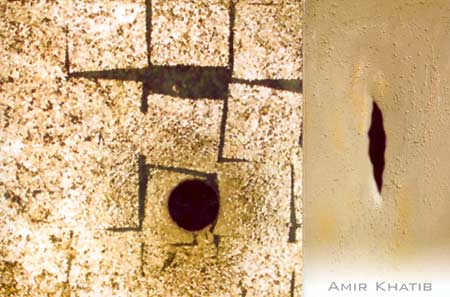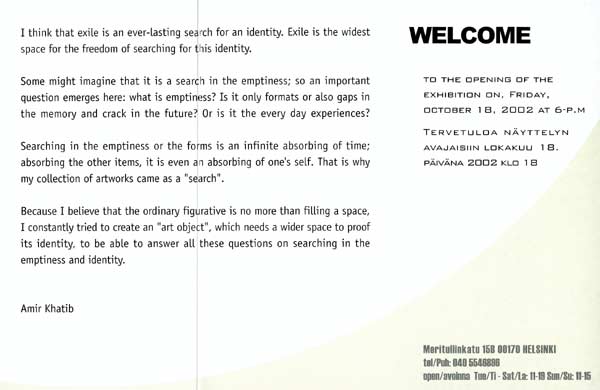
A Sociology Personified
By the Hand
Through the vacuous tares and holes, past the glitter of gold and feather, colour, texture and grain we are drawn deep within the realms of another humans beings most private, and inner sanctum ``absorbed´´ but still, and without restriction or bonds, we are free to roam, to wonder these endless, imaginary corridors and rooms that are both open, and on plane view to the fullest scrutiny. To open the many draws, cupboards and closets and to either freely address or quietly reflect upon the many parts that hold similarities in relation to that of our own unique psyches, and awareness about our selves or those more ‘ ‘not’ so perfect flaws’ that we are so reluctant to admit even to our selves, those places in us where, and by choice we so refuse to go.
‘………exile is an ever-lasting
search
for an identity’.
An intriguing question I felt when I read it. One that
Amir Khatib, the father and creator of these works had put forward in
his invitation flyer when he first presented his ‘The Three
Trinities’ exhibition at his base the ‘Galleria EU-MAN’
in Helsinki, Finland (October 18th 2002:) A question that, and upon viewing
his works, appears the stable point in what Khatib was addressing both
as an explanation as well as a thought provoking invitation to be mulled
over.
But that the term ‘exile’ itself orchestrates an array of
varying definitions both as what we, the individual person, perceives
whether it be politically motivated or socially, as a whole or singularly.
What perhaps stands out, and is most striking about the three bodies of
trinity…
`Happiness´, `Unsettlement´,
and `Waiting´, as well as with the two complementary
independent forms of, `Absorbsion´ and `The
Last Version´= (a singular piece at this stage) is that
they set the wheels of the mind in motion as the exuberance of Khatib’s
beliefs and idealisms, wishes and desires. Dreams and hopes perceptions
and character are clear in evidence as they flow freely trough the material
that is carefully needed through his work (via) his hands. As though his
use of colour form, symbolism and shape, distortion, bend and curve are
nothing more trimming, decoration, a formality for a Presentation for
the viewer but that the passion is what consumes even that of the least
discernable eye upon one entering the room as almost immediately one is
confronted with a dilemma of at which group ‘exactly’ should
one start? And as there appears to be no discernible beginning ‘nor’
end as though straight away one has, without realising, been enveloped
by both the artist and his world.
Jer Halpin
Poet/writer/Artist
